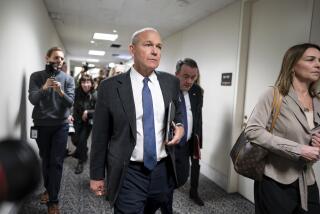Airports Still Lack the Machines to Detect Pan Am-Style Bomb : Security: FAA scrapped plans for devices to sniff out plastic explosives after the first six failed to work well.
- Share via
WASHINGTON — The bombing of a Pan Am jet three years ago triggered substantially tighter security at airports, federal officials said Thursday, but a big gap remains: a machine to detect the kind of plastic bomb that blew up Flight 103.
Metal detectors and X-ray machines have been upgraded, security people have received better training, baggage checking procedures have been strengthened and more fences have been built around radar towers and other sensitive facilities.
But the Federal Aviation Administration has been forced to scrap a plan to deploy 150 plastic-bomb-sniffing machines at a cost of $175 million because the first six that were used did not work well, Clyde Robbins, the FAA security chief, said in an interview.
The government hopes that a foolproof detector can be developed within a year or two, he said, but for now the FAA is having to fall back on a string of other security measures--most of which he declined to discuss because “that would tell terrorists what they are.”
“We think we’re a lot less vulnerable now than we were when Pan Am 103 went down,” Robbins said. “But we’d like to see better equipment primarily because so much now depends on the human factor. Screeners have got to be more alert, but that’s a damned boring business. So, if we can get more equipment out there, we’ll be a lot better off.”
Transportation Secretary Samuel K. Skinner said the government has carried out most of a law passed by Congress last year, adopting recommendations of an aviation security commission created by President Bush in the wake of the Pam Am bombing. The seven-member commission called the aviation security system “seriously flawed” and concluded that the destruction of Flight 103, which killed 259 people on the plane and 11 on the ground, “may well have been preventable.”
Skinner said in a statement: “We have already implemented 28 actions required by the law and have made substantial progress on 18 other actions which are scheduled to be completed in the next two years.”
Federal security managers have been installed at 18 of the nation’s major airports; the FAA has adopted more stringent requirements for airline and airport security workers. It also has required foreign air carriers operating in the United States to improve security.
The FAA also has beefed up its security staff, growing from 485 in December, 1988, to 825 now and 1,000 by next fall. A rule requiring criminal-record checks of airline and airport security workers is being processed. And FAA and FBI experts have begun an assessment of security at domestic airports that will be completed next fall.
When the Persian Gulf War erupted last January, the FAA raised airport security to the highest level ever. Precautions included increasing the number of police, allowing only ticketed passengers past screening points, prohibiting curbside check-in of luggage and towing away vehicles parked within 100 feet of an airport terminal. When the war ended, some of the measures were dropped, notably the bar on curbside luggage checks and the restrictions on non-passengers in the terminal.
“As we were able to see what went on, we were able to back off,” Robbins said. “We added some procedures that, for example, make the curbside service not as vulnerable as before.” He declined to specify the new procedures.
John Yee, manager at Los Angeles International Airport, said in a telephone interview that “we have addressed the major issues in regard to tightening up security on the perimeter and in the terminal.” For example, he said, “we are being more sensitive to foreign flights, screening all bags and profiling passengers.”
Security has been doubled at the airport for the air traffic control center that covers the Western region. And enhanced fencing, with concrete barriers topped by chain-link fencing and barbed wire, has been thrown up around aircraft fuel storage facilities. The city, which operates the airport, also has stepped up intelligence efforts aimed at identifying and thwarting potential terrorists.
Yee said that the airport is helping the FAA test machines that are being developed to “sniff” plastic explosives.
The FAA had planned to buy 150 thermal neutron analysis machines manufactured by Science Applications International Corp. of San Diego. But the machine proved to be ineffective, Robbins said, and has been withdrawn from four of six airports where it had been installed. Officials of the firm could not be reached for comment.
More to Read
Sign up for Essential California
The most important California stories and recommendations in your inbox every morning.
You may occasionally receive promotional content from the Los Angeles Times.










